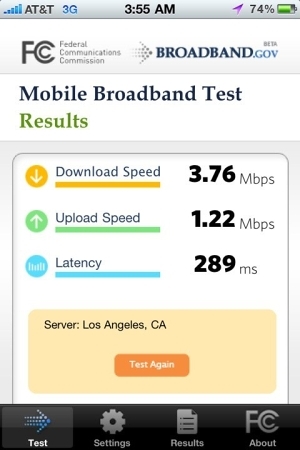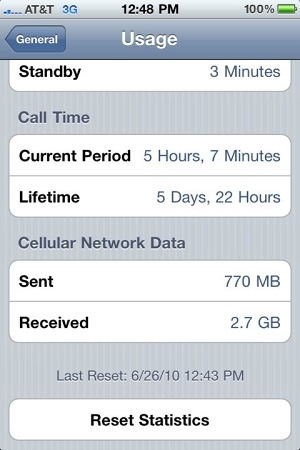Index
Network Improvements and HSUPA Upgrade
In addition to the CPU and memory upgrade, the iPhone 4 benefits from improved network speeds in areas where AT&T has deployed 5.76Mbit/sec HSUPA (High-Speed Uplink Packet Access), a theoretically major improvement over current speeds seen on the iPhone 3G and iPhone 3GS. Over the past twelve months, we have literally ran over 1,200 mobile broadband speed tests all around the Los Angeles / Orange County region of Southern California using the FCC Mobile Broadband Test app and can undoubtedly confirm that the maximum 3G upload speeds on the iPhone 3GS typically average 0.24Mbps and never exceed 0.27Mbps.
Over the past three weeks alone, we have already ran over 700 mobile broadband speed tests with the iPhone 4 and can confirm that our average upload speeds have jumped to 1.12Mbps and top out at 1.24Mbps. In one situation, we even stood 10 feet away from a fairly high-volume local AT&T UMTS tower at various points of the day and managed to find maximum throughput at 3.76Mbps down, 1.22Mbps up and 289ms latency to the nearest packet test server.

As a side note, we've also consumed over 2.7GB of cellular 3G HSPA data in the past three weeks alone. It looks like AT&T won't be able to take this enthusiast smartphone user off his unlimited data plan in the future without a good fight.

Battery Life
We could go into a much lengthier conversation about the SoC platform in the iPhone 4 and its general hardware performance compared to the previous few iPhone generations. But one of the bigger facets of hardware design that has always concerned the majority of iPhone consumers is battery life. Indeed, Apple's efforts before the iPhone 4 have been a pretty poor selling point in comparison to other smartphones that have made it big in the past 24 months. Nevertheless, the iPhone 4 features a gigantic 3.7V 1420mAh Lithium-Polymer battery, and Apple claims it can get up to 7 hours of talk time on 3G, up to 6 hours of Internet use on 3G (10 hours on WiFi), up to 10 hours of video, up to 40 hours of audio, and up to 300 hours of standby. In comparison, the iPhone 3GS has a capacity of 1219mAh and the iPhone 3G has a capacity of 1150mAh respectively.

(iPhone 4's new 3.7V 1420mAh Li-Polymer battery - iFixit.com)
Based on the teardown images, the battery connector is different than the one in the 3G and 3GS. Fortunately, it isn't soldered to the logic board and should allow battery replacement on the device to be fairly easy to accomplish.
In our iPhone 3GS review last year, we noted that both the iPhone 3G and the iPhone 3GS supply the same amount of juice regardless of Apple's improvement claims at the time. The ARM Cortex A8 crunches through data in a way that, when used at full speed, makes the 3GS run out of battery faster than the 3G. Likewise, the same scenario can partly be said for the iPhone 4. Despite having a larger battery and faster processor clockspeed based on the same architecture, the 800MHz A4 will consume more power at full speed than its 600MHz predecessor, and will consequently cause the phone to run out of battery almost as fast as the iPhone 3GS. Of course, there's a remarkably easy solution to remedy this, and it's built right into iOS 4 - simply close any unused background apps with the built-in task manager by double tapping the Home button and removing them from the selection list. We've noticed that many location-based apps, even when idling as background processes, will utilize the GPS radio and accelerometer for continuous tracking and can drain the battery very quickly. Thankfully, Google Maps doesn't exhibit this behavior, but popular third-party apps like MotionX GPS and Waze can pose a threat to battery life and will attempt to gulp the juice out of the iPhone 4 when unnoticed.
In contrast to the nature of battery consumption in Apple's rendition of multitasking, the iPhone 4 has a very impressive standby time under normal to light usage. We tested the phone overnight with an initial charge of 100 percent battery and checked up on it 14 hours later to find that it had only dropped to 98 percent. This behavior is similar to what the iPad exhibits when fully charged under normal to light usage. Overall, we're thankful that the new A4 architecture sips power under normal use conditions and can potentially spare us a few extra hours of standby time when the battery dips down to 6 percent and we're stuck in an emergency situation without a charger (hey, it happens to all of us).



